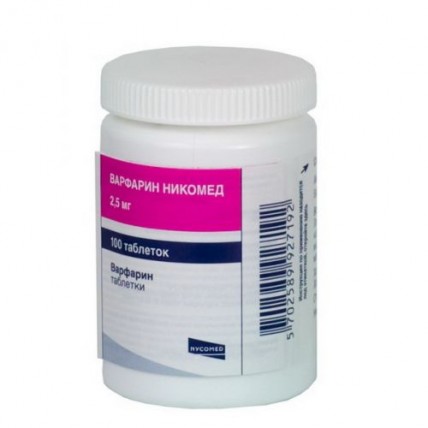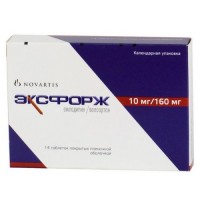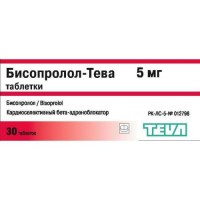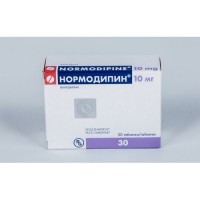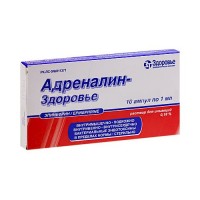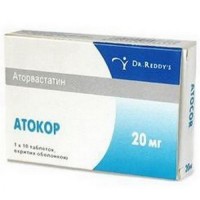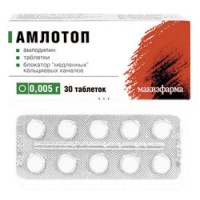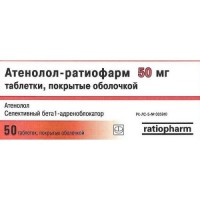Warfarin 2.5 mg (100 tablets)
- $8.70
Trade name
Nikomed Mezhdunarodnoye Warfarin the unlicensed
name Warfarin Dosage Form
of the Tablet of 2.5 mg
Structure
One tablet contains
active agent - warfarin of sodium of 2.5 mg,
excipients: lactose, starch corn, calcium hydrophosphate dihydrate, indigotin (E 132), povidone 30, magnesium stearate.
The description
Round, biconvex tablets of pale blue color, with a crosswise notch for a break.
Pharmacotherapeutic group
Anticoagulants. Antagonists of vitamin K.
The code of automatic telephone exchange B01AA03
Pharmacological
Pharmakokinetka Preparat properties is quickly soaked up from digestive tract. Linking with proteins of blood plasma makes 97 – 99%. It is metabolized in a liver. Varfarin represents racemic mix, and R- and S-isomers are metabolized in a liver in various ways. Each of isomers will be transformed to 2 main metabolites. The main catalyst of metabolism for S-enantiomer of warfarin is CYP2C9 enzyme, and for R-enantiomer of CYP1A2 and CYP3A4 warfarin. Left-handed isomer of warfarin (S – warfarin) has by 2 – 5 times bigger anticoagulating activity, than dextrorotatory isomer (R-enantiomer), however elimination half-life of the last is more. Patients with polymorphism of CYP2C9 enzyme, including alleles of CYP2C9*2 and CYP2C9*3, can have hypersensitivity to warfarin and the increased risk of developing bleedings.
Varfarin is brought from an organism in the form of inactive metabolites with bile which reabsorbirutsya in a GIT and are allocated with urine. Elimination half-life makes from 20 to 60 hours. For R-enantiomera the elimination half-life makes from 37 to 89 hours, and for S-enantiomera from 21 to 43 hours.
Pharmakodinimika
Varfarin – anticoagulant of indirect action, blocks in a liver synthesis vitamin of K-dependent blood-coagulation factors, namely, a factor of II, VII, IX and X. Concentration of these components in blood decreases, process of coagulability slows down. The beginning of anticoagulative action is observed in 36 – 72 hours from the beginning of administration of drug with development of the maximum effect for 5 – 7 day of the beginning of use. After the termination of administration of drug recovery of activity vitamin of K-dependent blood-coagulation factors occurs within 4 – 5 days.
Indications
Treatment and prevention of thromboses and embolisms of blood vessels, including:
- an acute vein thrombosis and an embolism of a pulmonary artery (in a combination with heparin)
- prevention and treatment of postoperative thromboses
- a repeated myocardial infarction
- at prosthetics of vessels and valves of heart (century of t. h in a combination with atetsilsalitsilovy acid)
- prevention of tromboembolic episodes at patients with fibrillation of auricles
- recuring fibrinferments
- fibrinferments of peripheral, coronary and brain arteries
- the passing ischemic attacks and strokes.
Preparat use for secondary prevention of thrombosis and a thrombembolia after a myocardial infarction and at atrial fibrillation.
The route of administration and doses
Varfarin is appointed 1 time a day time is desirable in one and too. Duration of treatment is defined by the doctor according to indications.
Control during treatment:
Before therapy define the International Normalized Relation (INR). Further laboratory control is carried out regularly by each 4 – 8 weeks. Duration of treatment depends on a clinical condition of the patient. Treatment can be cancelled at once.
Patients who did not accept Varfarin earlier:
The initial dose makes 5 mg/days (the 2nd tab. in day) during the first 4 days. For the 5th day of treatment MNO is defined and, according to this indicator, the maintenance dose of drug is appointed. Usually maintenance dose of drug makes 2.5 - 7.5 mg/day (1 – 3 tablets a day).
Patients who accepted Varfarin earlier:
The recommended initial dose makes a double dose of the known maintenance dose of drug and is appointed during the first 2 days. Then treatment is continued by means of the known maintenance dose. For the 5th day of treatment carry out control of MNO and dose adjustment according to this indicator.
Elderly people:
There are no special recommendations about intake of warfarin at elderly people.
However elderly patients have to be under careful observation since they have higher risk of development of side effects.
Patients with a liver failure:
Disturbance of functions of a liver increases sensitivity to warfarin as the liver produces blood-coagulation factors and also metabolizes warfarin. At this group of patients the careful monitoring of indicators of MNO is necessary.
Patients with a renal failure:
Patients with a renal failure do not need any special recommendations about selection of a dose of warfarin. The patients who are on peritoneal dialysis do not need additional increase in a dose of warfarin.
To patients to whom surgical intervention is necessary:
(at high risk of tromboembolic episodes), drug is recommended to appoint in 2 – 3 days before operation.
In acute thrombosis in addition appoint heparin during the first 3 – 5 days, the optimum anticoagulating effect of Nikomed Warfarin will not be shown yet.
At prosthetics of valves of heart, an acute vein thrombosis, primary embolisms, fibrinferments of a left ventricle and for prevention of a myocardial infarction try to obtain anticoagulative effect at MHO 2.8 up to 4.4.
In an atrial flutter and for maintenance therapy in vein thromboses and embolisms try to obtain obtaining moderate anticoagulative effect at MNO from 2.8 – 3.0.
Side effects
Adverse side reactions are distributed in the following order, taking into account emergence frequency: very often (≥1/10), it is frequent (≥1/100 to & lt, 1/10), is not frequent (≥1/1.000 to & lt, 1/100), is rare (≥1/10.000 to & lt, 1/1.000), is very rare (& lt, 1/10.000), unknown (it is impossible to estimate on the basis of the available data).
Very often:
- bleeding (nasal bleedings, a pneumorrhagia, a hamaturia, bleedings of gums, bruises, vaginal bleedings, cerebral hemorrhages, gastrointestinal bleeding, long and extensive bleedings after surgical intervention or an injury)
- increase in sensitivity to warfarin after prolonged use
Infrequently:
- anemia, vomiting, abdominal pain, nausea, diarrhea
Seldom:
- eosinophilia, increase in activity of enzymes of a liver, cholestatic hepatitis, jaundice, rash, small tortoiseshell, itching, eczema, skin necrosis, alopecia, vasculites, hair loss, nephrite, urolithiasis, tubular necrosis
Very seldom:
- palmar and bottom syndrome: symmetric purple damages of skin of fingers and sole of feet which are followed by thermalgias. After the termination of intake of warfarin the specified symptoms gradually disappear.
Independent risk factors of developing serious bleedings at treatment by warfarin are: advanced age, high intensity of the accompanying anticoagulating and anti-modular therapy, existence in the anamnesis of strokes and gastrointestinal bleedings.
The risk of bleedings is increased at patients with polymorphism of a gene of CYP2C9
of the Contraindication
- hypersensitivity to drug components
- pregnancy (first trimester and the last 4 weeks of pregnancy)
- a serious illness of a liver or kidneys
- acute bleeding of any localization
- high risk of bleedings (including patients with hemorrhagic disorders, a gullet varicosity, aneurysm of arteries, a lumbar puncture, a peptic ulcer of a stomach and a 12-perstny gut, thrombocytopenia)
- wounds (including operating rooms)
- a bacterial endocarditis
- malignant hypertensia
- a hemorrhagic stroke, intracraneal hemorrhages
- the children's age up to 18 years
Medicinal interactions
is not recommended to begin or stop intake of other medicines and also to change doses of the taken drugs without consultation with the attending physician.
At co-administration it is also necessary to consider effects of the termination of induction and/or inhibition of effect of warfarin other medicines.
Risk of developing heavy bleedings increases at a concomitant use of warfarin with the drugs influencing the level of thrombocytes and primary hemostasis: acetylsalicylic acid, klopidogret, tiklopidin, Dipiridamolum, the majority of non-steroidal anti-inflammatory drugs (except for cyclooxygenase-2 inhibitors), antibiotics of group of penicillin in high doses.
Also it is necessary to avoid the combined use of warfarin with the drugs possessing the significant inhibiting effect on the system of P450 cytochrome, for example, Cimetidinum and chloramphenicol at which intake during several days the danger of bleeding increases. In similar cases Cimetidinum can be replaced, for example, with ranitidine or famotidine.
The effect of warfarin can amplify at a concomitant use with the following medicines: acetylsalicylic acid, Allopyrinolum, Amiodaronum, azapropazon, azithromycin, alpha and beta interferon, amitriptyline, bezafibrat, vitamin A, vitamin E, glibenclamide, a glucagon, gemfibrozit, heparin, grepafloksatsin, danazol, dextropropoxyphene, (dekstro) - tyrosine, digoxin, Disulfiramum, zafirlukast, indometacin, ifosfamid, itrakonazol, carboxyuridine, ketokonazol, klaritromitsin, Clofibratum, codeine, levamisole, lovastatin, metolazon, a methotrexate, metronidazole, Miconazolum (including in the form of oral cavity gel), to moksalata, Acidum nalidixicum, norfloxacin, ofloxacin, omeprazolum, oksifenbutazon, paracetamol (especially after 1 – 2 weeks of constant reception), paroksetin, piroxicam, proguanil, propafenon, propranolol, anti-influenza vaccine, roksitromitsin, sertraline, simvastatin, sulfafurazol, sulfametizol, sulfamethoxazole-Trimethoprimum, sulfafenazol, Sulfinpyrazonum, sulfofenur, Sulindac, steroid hormones (anabolic and/or androgenic), tamoxifen, Tegafurum, testosterone, tetracyclines, thiensilt acid, tolmetin, trastuzumab, troglitazon, Phenytoinum, phenylbutazone, fenofibrat, feprazon, flukonazol, fluoxetine, ftoruratsit, flutamid, fluvastatin, phosphamide, quinine, quinidine, Chlorali hydras, chloramphenicol, tselekoksib, tsefamandol, cefalexin, tsefmenoksy, tsefmetazol, tsefoperazon, tsefuroksy, Cimetidinum, ciprofloxacin, cyclophosphamide, erythromycin, etopozid, ethanol.
Drugs of some herbs (ofitsinalny or neofitsinalny) also can how to enhance effect of warfarin: for example, a ginkgo (Ginkgo biloba), garlic (Allium sativum), an angelica medicinal (Angelica sinensis), a papaya (Carica papaya), a sage (Salvia miltiorrhiza) and to reduce: for example: Panax ginseng, St. John's wort (Hypericum perforatum).
It is impossible to take at the same time warfarin and any drugs of a St. John's wort, at the same time it is necessary to consider that the effect of induction of effect of warfarin can remain within 2 more weeks after the termination of administration of drugs of a St. John's wort. In case the patient takes the St. John's wort drugs, it is necessary to measure MHO and to stop reception.
Monitoring of MNO has to be careful since its level can increase at cancellation of a St. John's wort. After that it is possible to appoint warfarin.
Effect of warfarin can strengthen the quinine which is contained in tonics.
Warfarin can strengthen action of oral hypoglycemic means of derivatives of sulphonylurea.
The effect of warfarin can be weakened at a concomitant use with the following medicines: Azathioprinum, aminoglutetimidy, barbiturates, valproic acid, vitamin C, vitamin K, glutetimidy, griseofulvin, ikloksatsilliny, Disopyramidum, carbamazepine, coenzyme Q10, Mercaptopurinum, mesalaziny, mianseriny, Mitotanum, naftsilliny, Primidonum, retinoids, ritonaviry, rifampicin, rofekoksiby, Spironolactonum, sukralfaty, Trazodonum, chlordiazepoxide, Chlortalidonum, holestiraminy, cyclosporine.
Intake of diuretics in case of the significant hypovolemic action can lead to increase in concentration of factors of coagulability that reduces effect of anticoagulants.
The food rich with vitamin K weakens effect of warfarin, the vitamin K absorption reduction caused by diarrhea or intake of depletive exponentiates effect of warfarin.
Special instructions
It is necessary to weigh possible advantage of prevention of thromboembolic diseases and the increased risk of bleeding. Patients have to be warned about need of strict observance of the recommended drug dosing mode.
With care appoint drug at disturbances of processes of fibrillation, thrombocytopenia, a hyperthyroidism, arterial hypertension, in a peptic ulcer of a stomach and duodenum in an aggravation phase, in an abnormal liver function and kidneys, hemorrhages in a brain and a sick alcoholism.
The patients having alcoholism and also patients with dementia, can be incapable to observe the ordered mode of intake of warfarin.
Such states as fever, a hyperthyroidism, vomiting, diarrhea, dekompensirovanny heart failure, alcoholism with the accompanying damages of a liver, can strengthen effect of warfarin. At a hypothyroidism the effect of warfarin can be reduced. In case of a renal failure or a nephrotic syndrome the level of free fraction of warfarin in blood plasma which depending on associated diseases can lead as strengthening, and to decrease in effect increases. In case of a moderate liver failure the effect of warfarin amplifies.
In all above-mentioned states the careful monitoring of the MHO level has to be carried out.
The patients receiving warfarin as the anesthetizing drugs are recommended to appoint paracetamol, tramadol or opiates.
Patients with a mutation of the gene coding CYP2C9 enzyme have longer elimination half-life of warfarin. Lower doses of drug since at reception of usual therapeutic doses the risk of bleedings increases are required for these patients.
It is not necessary to accept warfarin to patients with hereditary intolerance of a galactose, deficiency of enzyme of lactase, disturbance of absorption of glucose and a galactose.
In case of need approaches of fast antitrombichesky effect, treatment is recommended to begin with administration of heparin, then within 5-7 days it is necessary to carry out combination therapy by heparin and warfarin until the target MHO level does not remain within 2 days.
In order to avoid coumarinic necrosis to patients with hereditary insufficiency of an antitrombichesky protein of C or S at first heparin has to be entered.
The accompanying initial dose of loading should not exceed 5 mg. Administration of heparin has to continue within 5-7 days.
In case of individual resistance to warfarin (meets very seldom) the achievement of therapeutic effect requires from 5 to 20 shock doses of warfarin. If intake of warfarin at such patients is inefficient, it is necessary to establish also other possible reasons as that: a concomitant use of warfarin with other medicines (see appropriate section of this instruction), an inadequate diet, laboratory mistakes.
Warfarin has to be cancelled before carrying out surgeries, including dental.
Treatment of patients of advanced age has to be carried out with special precautions since synthesis of factors of coagulation and hepatic metabolism at such patients decreases owing to what the overshot effect from effect of warfarin can occur.
It is necessary to eat food containing vitamin K with care.
The lactation
Warfarin is allocated with breast milk in not defined quantities and does not influence processes of fibrillation at the baby, therefore, drug can be used during breastfeeding, but for full safety the child should not receive some maternal milk during the first three days of treatment of mother drug.
The feature of influence of drug on ability to run the vehicle or potentially dangerous mechanisms
does not influence.
Overdose
Symptoms: the optimum level of treatment lies on borders of development of bleedings therefore the patient can have insignificant bleedings, for example, a microhematuria, bleeding of gums, pallor, hematomas around joints and on buttocks, blood in urine and excrements. The dorsodynia, an abdominal pain, vomiting, rash can include other symptoms. In hard cases a cerebral hemorrhage, hemorrhagic shock.
Treatment: in mild cases it is enough to lower a dose of drug or to stop treatment for short term. In insignificant bleedings it is enough to stop administration of drug before achievement of MNO of target level. In case of development of heavy bleeding – administration of vitamin K
(intravenously) and activated carbon, a concentrate of factors of coagulation or freshly frozen plasma.
If oral anticoagulants are shown to appointment further, it is necessary to avoid high doses of vitamin K as the resistance to Warfarin develops within 2 weeks. After performing treatment the long observation of the patient is necessary.
The form of release and packing
On 50 or 100 tablets place in a bottle polyethylene, corked by a cap polyethylene.
1 bottle together with the instruction for medical use in the state and Russian languages is put in a pack cardboard
by
Storage conditions
to Store at a temperature not over 25º C.
To store out of children's reach.
Period of storage
of 5 years.
Not to use after an expiration date.
Prescription status
According to the prescription
the Producer Nikomed of JV Pharm. z the lake of the lake, Poland
to Develop
Nikomed Mezhdunarodnoye Warfarin the unlicensed
name Warfarin Dosage Form
of the Tablet of 2.5 mg
Structure
One tablet contains
active agent - warfarin of sodium of 2.5 mg,
excipients: lactose, starch corn, calcium hydrophosphate dihydrate, indigotin (E 132), povidone 30, magnesium stearate.
The description
Round, biconvex tablets of pale blue color, with a crosswise notch for a break.
Pharmacotherapeutic group
Anticoagulants. Antagonists of vitamin K.
The code of automatic telephone exchange B01AA03
Pharmacological
Pharmakokinetka Preparat properties is quickly soaked up from digestive tract. Linking with proteins of blood plasma makes 97 – 99%. It is metabolized in a liver. Varfarin represents racemic mix, and R- and S-isomers are metabolized in a liver in various ways. Each of isomers will be transformed to 2 main metabolites. The main catalyst of metabolism for S-enantiomer of warfarin is CYP2C9 enzyme, and for R-enantiomer of CYP1A2 and CYP3A4 warfarin. Left-handed isomer of warfarin (S – warfarin) has by 2 – 5 times bigger anticoagulating activity, than dextrorotatory isomer (R-enantiomer), however elimination half-life of the last is more. Patients with polymorphism of CYP2C9 enzyme, including alleles of CYP2C9*2 and CYP2C9*3, can have hypersensitivity to warfarin and the increased risk of developing bleedings.
Varfarin is brought from an organism in the form of inactive metabolites with bile which reabsorbirutsya in a GIT and are allocated with urine. Elimination half-life makes from 20 to 60 hours. For R-enantiomera the elimination half-life makes from 37 to 89 hours, and for S-enantiomera from 21 to 43 hours.
Pharmakodinimika
Varfarin – anticoagulant of indirect action, blocks in a liver synthesis vitamin of K-dependent blood-coagulation factors, namely, a factor of II, VII, IX and X. Concentration of these components in blood decreases, process of coagulability slows down. The beginning of anticoagulative action is observed in 36 – 72 hours from the beginning of administration of drug with development of the maximum effect for 5 – 7 day of the beginning of use. After the termination of administration of drug recovery of activity vitamin of K-dependent blood-coagulation factors occurs within 4 – 5 days.
Indications
Treatment and prevention of thromboses and embolisms of blood vessels, including:
- an acute vein thrombosis and an embolism of a pulmonary artery (in a combination with heparin)
- prevention and treatment of postoperative thromboses
- a repeated myocardial infarction
- at prosthetics of vessels and valves of heart (century of t. h in a combination with atetsilsalitsilovy acid)
- prevention of tromboembolic episodes at patients with fibrillation of auricles
- recuring fibrinferments
- fibrinferments of peripheral, coronary and brain arteries
- the passing ischemic attacks and strokes.
Preparat use for secondary prevention of thrombosis and a thrombembolia after a myocardial infarction and at atrial fibrillation.
The route of administration and doses
Varfarin is appointed 1 time a day time is desirable in one and too. Duration of treatment is defined by the doctor according to indications.
Control during treatment:
Before therapy define the International Normalized Relation (INR). Further laboratory control is carried out regularly by each 4 – 8 weeks. Duration of treatment depends on a clinical condition of the patient. Treatment can be cancelled at once.
Patients who did not accept Varfarin earlier:
The initial dose makes 5 mg/days (the 2nd tab. in day) during the first 4 days. For the 5th day of treatment MNO is defined and, according to this indicator, the maintenance dose of drug is appointed. Usually maintenance dose of drug makes 2.5 - 7.5 mg/day (1 – 3 tablets a day).
Patients who accepted Varfarin earlier:
The recommended initial dose makes a double dose of the known maintenance dose of drug and is appointed during the first 2 days. Then treatment is continued by means of the known maintenance dose. For the 5th day of treatment carry out control of MNO and dose adjustment according to this indicator.
Elderly people:
There are no special recommendations about intake of warfarin at elderly people.
However elderly patients have to be under careful observation since they have higher risk of development of side effects.
Patients with a liver failure:
Disturbance of functions of a liver increases sensitivity to warfarin as the liver produces blood-coagulation factors and also metabolizes warfarin. At this group of patients the careful monitoring of indicators of MNO is necessary.
Patients with a renal failure:
Patients with a renal failure do not need any special recommendations about selection of a dose of warfarin. The patients who are on peritoneal dialysis do not need additional increase in a dose of warfarin.
To patients to whom surgical intervention is necessary:
(at high risk of tromboembolic episodes), drug is recommended to appoint in 2 – 3 days before operation.
In acute thrombosis in addition appoint heparin during the first 3 – 5 days, the optimum anticoagulating effect of Nikomed Warfarin will not be shown yet.
At prosthetics of valves of heart, an acute vein thrombosis, primary embolisms, fibrinferments of a left ventricle and for prevention of a myocardial infarction try to obtain anticoagulative effect at MHO 2.8 up to 4.4.
In an atrial flutter and for maintenance therapy in vein thromboses and embolisms try to obtain obtaining moderate anticoagulative effect at MNO from 2.8 – 3.0.
Side effects
Adverse side reactions are distributed in the following order, taking into account emergence frequency: very often (≥1/10), it is frequent (≥1/100 to & lt, 1/10), is not frequent (≥1/1.000 to & lt, 1/100), is rare (≥1/10.000 to & lt, 1/1.000), is very rare (& lt, 1/10.000), unknown (it is impossible to estimate on the basis of the available data).
Very often:
- bleeding (nasal bleedings, a pneumorrhagia, a hamaturia, bleedings of gums, bruises, vaginal bleedings, cerebral hemorrhages, gastrointestinal bleeding, long and extensive bleedings after surgical intervention or an injury)
- increase in sensitivity to warfarin after prolonged use
Infrequently:
- anemia, vomiting, abdominal pain, nausea, diarrhea
Seldom:
- eosinophilia, increase in activity of enzymes of a liver, cholestatic hepatitis, jaundice, rash, small tortoiseshell, itching, eczema, skin necrosis, alopecia, vasculites, hair loss, nephrite, urolithiasis, tubular necrosis
Very seldom:
- palmar and bottom syndrome: symmetric purple damages of skin of fingers and sole of feet which are followed by thermalgias. After the termination of intake of warfarin the specified symptoms gradually disappear.
Independent risk factors of developing serious bleedings at treatment by warfarin are: advanced age, high intensity of the accompanying anticoagulating and anti-modular therapy, existence in the anamnesis of strokes and gastrointestinal bleedings.
The risk of bleedings is increased at patients with polymorphism of a gene of CYP2C9
of the Contraindication
- hypersensitivity to drug components
- pregnancy (first trimester and the last 4 weeks of pregnancy)
- a serious illness of a liver or kidneys
- acute bleeding of any localization
- high risk of bleedings (including patients with hemorrhagic disorders, a gullet varicosity, aneurysm of arteries, a lumbar puncture, a peptic ulcer of a stomach and a 12-perstny gut, thrombocytopenia)
- wounds (including operating rooms)
- a bacterial endocarditis
- malignant hypertensia
- a hemorrhagic stroke, intracraneal hemorrhages
- the children's age up to 18 years
Medicinal interactions
is not recommended to begin or stop intake of other medicines and also to change doses of the taken drugs without consultation with the attending physician.
At co-administration it is also necessary to consider effects of the termination of induction and/or inhibition of effect of warfarin other medicines.
Risk of developing heavy bleedings increases at a concomitant use of warfarin with the drugs influencing the level of thrombocytes and primary hemostasis: acetylsalicylic acid, klopidogret, tiklopidin, Dipiridamolum, the majority of non-steroidal anti-inflammatory drugs (except for cyclooxygenase-2 inhibitors), antibiotics of group of penicillin in high doses.
Also it is necessary to avoid the combined use of warfarin with the drugs possessing the significant inhibiting effect on the system of P450 cytochrome, for example, Cimetidinum and chloramphenicol at which intake during several days the danger of bleeding increases. In similar cases Cimetidinum can be replaced, for example, with ranitidine or famotidine.
The effect of warfarin can amplify at a concomitant use with the following medicines: acetylsalicylic acid, Allopyrinolum, Amiodaronum, azapropazon, azithromycin, alpha and beta interferon, amitriptyline, bezafibrat, vitamin A, vitamin E, glibenclamide, a glucagon, gemfibrozit, heparin, grepafloksatsin, danazol, dextropropoxyphene, (dekstro) - tyrosine, digoxin, Disulfiramum, zafirlukast, indometacin, ifosfamid, itrakonazol, carboxyuridine, ketokonazol, klaritromitsin, Clofibratum, codeine, levamisole, lovastatin, metolazon, a methotrexate, metronidazole, Miconazolum (including in the form of oral cavity gel), to moksalata, Acidum nalidixicum, norfloxacin, ofloxacin, omeprazolum, oksifenbutazon, paracetamol (especially after 1 – 2 weeks of constant reception), paroksetin, piroxicam, proguanil, propafenon, propranolol, anti-influenza vaccine, roksitromitsin, sertraline, simvastatin, sulfafurazol, sulfametizol, sulfamethoxazole-Trimethoprimum, sulfafenazol, Sulfinpyrazonum, sulfofenur, Sulindac, steroid hormones (anabolic and/or androgenic), tamoxifen, Tegafurum, testosterone, tetracyclines, thiensilt acid, tolmetin, trastuzumab, troglitazon, Phenytoinum, phenylbutazone, fenofibrat, feprazon, flukonazol, fluoxetine, ftoruratsit, flutamid, fluvastatin, phosphamide, quinine, quinidine, Chlorali hydras, chloramphenicol, tselekoksib, tsefamandol, cefalexin, tsefmenoksy, tsefmetazol, tsefoperazon, tsefuroksy, Cimetidinum, ciprofloxacin, cyclophosphamide, erythromycin, etopozid, ethanol.
Drugs of some herbs (ofitsinalny or neofitsinalny) also can how to enhance effect of warfarin: for example, a ginkgo (Ginkgo biloba), garlic (Allium sativum), an angelica medicinal (Angelica sinensis), a papaya (Carica papaya), a sage (Salvia miltiorrhiza) and to reduce: for example: Panax ginseng, St. John's wort (Hypericum perforatum).
It is impossible to take at the same time warfarin and any drugs of a St. John's wort, at the same time it is necessary to consider that the effect of induction of effect of warfarin can remain within 2 more weeks after the termination of administration of drugs of a St. John's wort. In case the patient takes the St. John's wort drugs, it is necessary to measure MHO and to stop reception.
Monitoring of MNO has to be careful since its level can increase at cancellation of a St. John's wort. After that it is possible to appoint warfarin.
Effect of warfarin can strengthen the quinine which is contained in tonics.
Warfarin can strengthen action of oral hypoglycemic means of derivatives of sulphonylurea.
The effect of warfarin can be weakened at a concomitant use with the following medicines: Azathioprinum, aminoglutetimidy, barbiturates, valproic acid, vitamin C, vitamin K, glutetimidy, griseofulvin, ikloksatsilliny, Disopyramidum, carbamazepine, coenzyme Q10, Mercaptopurinum, mesalaziny, mianseriny, Mitotanum, naftsilliny, Primidonum, retinoids, ritonaviry, rifampicin, rofekoksiby, Spironolactonum, sukralfaty, Trazodonum, chlordiazepoxide, Chlortalidonum, holestiraminy, cyclosporine.
Intake of diuretics in case of the significant hypovolemic action can lead to increase in concentration of factors of coagulability that reduces effect of anticoagulants.
The food rich with vitamin K weakens effect of warfarin, the vitamin K absorption reduction caused by diarrhea or intake of depletive exponentiates effect of warfarin.
Special instructions
It is necessary to weigh possible advantage of prevention of thromboembolic diseases and the increased risk of bleeding. Patients have to be warned about need of strict observance of the recommended drug dosing mode.
With care appoint drug at disturbances of processes of fibrillation, thrombocytopenia, a hyperthyroidism, arterial hypertension, in a peptic ulcer of a stomach and duodenum in an aggravation phase, in an abnormal liver function and kidneys, hemorrhages in a brain and a sick alcoholism.
The patients having alcoholism and also patients with dementia, can be incapable to observe the ordered mode of intake of warfarin.
Such states as fever, a hyperthyroidism, vomiting, diarrhea, dekompensirovanny heart failure, alcoholism with the accompanying damages of a liver, can strengthen effect of warfarin. At a hypothyroidism the effect of warfarin can be reduced. In case of a renal failure or a nephrotic syndrome the level of free fraction of warfarin in blood plasma which depending on associated diseases can lead as strengthening, and to decrease in effect increases. In case of a moderate liver failure the effect of warfarin amplifies.
In all above-mentioned states the careful monitoring of the MHO level has to be carried out.
The patients receiving warfarin as the anesthetizing drugs are recommended to appoint paracetamol, tramadol or opiates.
Patients with a mutation of the gene coding CYP2C9 enzyme have longer elimination half-life of warfarin. Lower doses of drug since at reception of usual therapeutic doses the risk of bleedings increases are required for these patients.
It is not necessary to accept warfarin to patients with hereditary intolerance of a galactose, deficiency of enzyme of lactase, disturbance of absorption of glucose and a galactose.
In case of need approaches of fast antitrombichesky effect, treatment is recommended to begin with administration of heparin, then within 5-7 days it is necessary to carry out combination therapy by heparin and warfarin until the target MHO level does not remain within 2 days.
In order to avoid coumarinic necrosis to patients with hereditary insufficiency of an antitrombichesky protein of C or S at first heparin has to be entered.
The accompanying initial dose of loading should not exceed 5 mg. Administration of heparin has to continue within 5-7 days.
In case of individual resistance to warfarin (meets very seldom) the achievement of therapeutic effect requires from 5 to 20 shock doses of warfarin. If intake of warfarin at such patients is inefficient, it is necessary to establish also other possible reasons as that: a concomitant use of warfarin with other medicines (see appropriate section of this instruction), an inadequate diet, laboratory mistakes.
Warfarin has to be cancelled before carrying out surgeries, including dental.
Treatment of patients of advanced age has to be carried out with special precautions since synthesis of factors of coagulation and hepatic metabolism at such patients decreases owing to what the overshot effect from effect of warfarin can occur.
It is necessary to eat food containing vitamin K with care.
The lactation
Warfarin is allocated with breast milk in not defined quantities and does not influence processes of fibrillation at the baby, therefore, drug can be used during breastfeeding, but for full safety the child should not receive some maternal milk during the first three days of treatment of mother drug.
The feature of influence of drug on ability to run the vehicle or potentially dangerous mechanisms
does not influence.
Overdose
Symptoms: the optimum level of treatment lies on borders of development of bleedings therefore the patient can have insignificant bleedings, for example, a microhematuria, bleeding of gums, pallor, hematomas around joints and on buttocks, blood in urine and excrements. The dorsodynia, an abdominal pain, vomiting, rash can include other symptoms. In hard cases a cerebral hemorrhage, hemorrhagic shock.
Treatment: in mild cases it is enough to lower a dose of drug or to stop treatment for short term. In insignificant bleedings it is enough to stop administration of drug before achievement of MNO of target level. In case of development of heavy bleeding – administration of vitamin K
(intravenously) and activated carbon, a concentrate of factors of coagulation or freshly frozen plasma.
If oral anticoagulants are shown to appointment further, it is necessary to avoid high doses of vitamin K as the resistance to Warfarin develops within 2 weeks. After performing treatment the long observation of the patient is necessary.
The form of release and packing
On 50 or 100 tablets place in a bottle polyethylene, corked by a cap polyethylene.
1 bottle together with the instruction for medical use in the state and Russian languages is put in a pack cardboard
by
Storage conditions
to Store at a temperature not over 25º C.
To store out of children's reach.
Period of storage
of 5 years.
Not to use after an expiration date.
Prescription status
According to the prescription
the Producer Nikomed of JV Pharm. z the lake of the lake, Poland
to Develop
